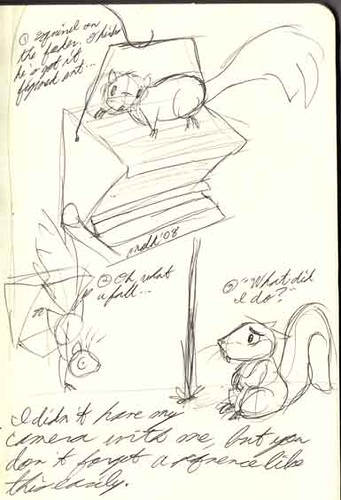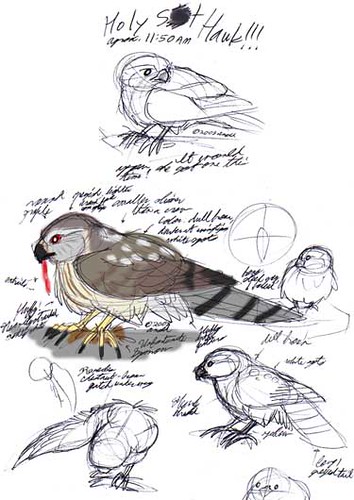
Once again, it is time to set up our bird feeders and fill them with delicious treats for our favorite winged theropods. It's time to switch our weather alerts to Celsius. It's time to participate in the Cornell Lab of Ornithology's Project Feederwatch.
Data on the migratory and feeding patterns of backyard birds is very valuable, and Feederwatch is probably the easiest of Cornell's citizen science projects to participate in. It couldn't be simpler:
1) Choose two consecutive days per week. Weekends are fine.
2) Keep an eye on your backyard during these days. It doesn't matter if it's all day or a few minutes.
3) Keep a log of (a) the weather and (b) how many birds of each species you see at a time.
This last part is often confusing for some people. If you look out the window on Saturday and see twenty House Sparrows (as an aside, it's okay to estimate if the birds arrive in big flocks), write that down. If you look out on Sunday and see fifty sparrows, scratch out your "twenty" count and write that down. This is because of part 4:
4) At the end of your second day, go to the Cornell Data Entry website and record the LARGEST number for each species you have seen over your two days.
And that's basically it. Really, all the information you need is at the Cornell website.
There are a few readers last year who were curious as to what birdseed I use. As you can see in the picture above, I use a blend. If you're making your own blend, start with sunflower seeds. Note that Black-Oil Sunflower seeds are easiest for birds to consume. I remember years ago being able to purchase bulk bags of Striped Sunflower seeds, but it seems as though those seeds are being relegated to being human food. You can experiment with Striped if you can find some that haven't been roasted, flavored, salted, or what-have-you.
Add some unsalted, unflavored, un-messed-around-with peanuts. You can experiment with other nuts (especially tree nuts), and small dried fruits like raisins and "craisins" are usually a big hit too, especially in winter. Avoid trail mixes as these often contain chocolate (as bad for birds as it is for dogs, poor things), yogurt, and other weird foods. The very patient among us can start collecting fruit seeds, like I have with the pumpkins (argh but not with the record number of Gala apples I consumed this autumn.)
Speaking of fruit, overripe fruit can go over well with wild animals. But, and I cannot emphasize this enough, DO NOT BE CHEAP AND TOSS STALE BREAD OUT THERE BREAD IS BASICALLY THE WORST THING YOU COULD FEED A BIRD!!!!! Read this Tetrapod Zoology post for more - much more; more than you could ever possibly want to know - about this. Aside from fruit, there are also... let's call them more exotic options. (For the record, this is a line I will not cross.)
So I usually get one big bag of sunflower seeds and a little bag of mixed seeds (this covers the "little stuff"), a jar of shelled peanuts, and a big box of raisins. And I can usually get all of this for a decent price at Ocean State Job Lot. (I have a future post in me arguing against expensive bird seed -- but keep in mind that the primary consumers of my seeds are house sparrows. Your mileage may vary.) I mix everything together in --this is very important-- a big plastic tub with a lid that closes very tightly. I even go further and keep my tub well off the ground and weigh the lid down. You want the critters to stay in the yard, not venture into the basement.
And speaking of critters...

Tolerance of mammals at your bird feeder is another "mileage may vary" issue. Some people are totally cool with the occasional squirrel. I am too -- as long as they are scarfing up whatever has fallen out of the feeder and aren't raiding the feeder itself.
To that end, I can't recommend a squirrel-proof feeder highly enough. The one I use is a hopper feeder that has a counterweight design; there's a little door above the opening that snaps shut if something that weighs a lot more than a bird sits on the perch. (It's not this model, but it looks very similar.) It has the added advantage of making sure huge crowds of house sparrows can't empty the feeder in one sitting (which, unfortunately, they absolutely will).
There are other designs, including the spectacular Yankee Flipper (here's a video of this thing in action, with a perfect soundtrack, and I get the sense that Droll Yankee invented it just for the LOLs.) If you don't have access to these feeders, a "baffle" works pretty well, and you could always try greasing your feeder pole. Best thing to do, really, is resign yourself to the fact that, if a squirrel could smell birdseed on Mars, he'd find some way to get at it.
I set my feeder in an area that's relatively hidden from the street, not too close to the hedges where the sparrows hang out and where predators could lurk, and in kind of an open spot among the lilacs (not to close to the trees that squirrels could jump from them to the feeder, but close enough for the birds to feel they could dive in them for safety if the neighbors' cat comes to investigate.) And, of course, it's in full view of my biggest window, without being anywhere near the window. Having birds flying around near a big window is just inevitably going to end in tragedy. On a similar note, keep your cats and dogs inside during the mid-morning and afternoon, as those tend to be the peak feeding times.

While we are on the subject of Carnivore Confusion, I tolerate hawks. The very few I have seen always go after the house sparrows. If you do not enjoy the sight of a Sharpie PWNING a sparrow in your own backyard, then what kind of birdwatcher ARE you?
I'll write more about bird feeding once I actually get my feeder up, as there are a lot of issues yet to cover. For those of you starting your counts early, good luck! Here's to a great season!
